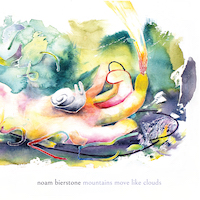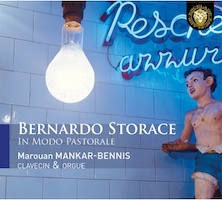A Ramble, Fairly Eclectic, with Turntables
|
Grant Chu Covell [October 2022.]
“Turning World.” Shiva FESHAREKI: Aetherworld (2021)1. Daphne ORAM: Still Point (1948-50; ver. Shiva FESHAREKI and James BULLEY, 2018)2. Shiva Feshareki1,2 (turntables, electronics), James Bulley2 (electronics), Kit Downes1 (org), BBC Singers1, London Contemporary Orchestra2, Sofi Jeannin1, Robert Ames2 (cond.). NMC D266 (1 CD) (www.nmcrec.co.uk). Here’s a healthily unclassifiable release, worth a dedicated listen as it dusts off and frames something historic. Feshareki (b. 1987) is an accomplished turntablist, and Oram (1925-2003) was an early electronic music composer. Aetherworld, Feshareki’s work for chorus, organ, turntables and electronics, offers an array of beguiling sounds. The otherworldly whirring might recall mid-century horror movie scores, whereas other spots suggest Ligeti. The organ becomes more prominent towards the end, raising the roof on twenty primordial but avant-garde minutes. On a recording we may miss how Feshareki’s sounds are projected through space or the chorus’ versatility. Let’s credit Oram with the first realtime electronic editing of live musicians. Her piece has two orchestras, one meant to sound “dry” and the other “wet” through amplification and effects. Oram’s reasonably tonal approach to instrumental material might not lend itself ideally to her intended transformations, but it probably was cutting edge in late 1940’s England. There are passages where a string ensemble enhanced with reverb appears to swim against crisply executed winds. As it happens, dissonance isn’t necessarily helpful for Oram, so the film-score style clarifies the expected effects. Still Point was a reaction to surviving WWII in London. Oram was responsible for BBC radio broadcasts, readying recorded sides in case the musicians had to clear the Royal Albert Hall stage. Does it compare with other war symphonies? (I am thinking of another British composer celebrating a big anniversary this month.) It actually does, once the circumstance becomes clear. Feshareki contributes something like a cadenza between Still Point’s two parts.
“Collage de temps.” Martin LOHSE: Collage de temps (2013)1; 5 momenti mobile (2013)2; Moto immoto (2009; vers. 2015)3. David Lau Magnussen1,2 (pno), Bjarke Mogensen2, Claudio Jacomucci2 (accordion), Christina Åstrand2 (vln), Toke Møldrup2 (vlc), Danish Chamber Players1,3, Casper Schreiber1,3 (cond.). Dacapo 8.226590 (1 CD) (www.dacapo-records.dk). Collage de temps situates the piano in its tinkly, high register where it cuts across what sounds like a salon orchestra (trumpet doubling violins) not unlike Nyman, however Lohse (b. 1971) shies from exuberance, conserving energy. I suppose there is a skill in Lohse’s flattened minimalism, juxtaposed phrases without consequence, like an aisle of music boxes, lined up in a tidy row. Lohse calls his technique “mobile.” Comfortable tonal passages are sequenced and occasionally repeated without regard to continuity, thus taking on a new character in relation to different surroundings. The results avoid dissonance and can feel familiar, despite quirky modulations. The casualness is reinforced with the unusual combination of piano trio plus accordion duet in 5 momenti mobile, five movements comprising a suite. Moto immoto is a melancholy trek (perhaps a chaconne) through slower, possibly Romantically inspired phrases, a chamber symphony of unyielding transitions. Overall, the three pieces give a cool impression despite the Danish players’ enthusiasm.
“Fonogramatika.” Antanas REKAŠIUS: Epitaph (1980)1; Atonic (1970)2; Phonogram (1980)3; Fluorescences (1981)4; Musica dolente e con brio (1980)5. Apartment House: Frank Gratkowski1,3,5 (sax, fl, clar), Simon Limbrick1,3,5 (perc), Anton Lukoszevieze1,3,4,5 (vlc), Philip Thomas2 (pno), Kerry Yong4 (synthesizer). Music Information Centre Lithuania, MICL CD 089 (1 CD) (www.mic.lt). Apartment House discovers the playful and elliptical work of Antanas Rekašius (1928-2003). This program interleaves chamber music with cello around solo piano pieces. For the most part, Rekašius is economical, but incredibly inclined to mischief, sometimes starting or stopping mid-thought. Satie would be a precedent, but Rekašius is darker and more confidently misleading, and except for suggestions of tunes and some jazzy percussion riffs, appears happily oblivious to history. Ideas appear, they may twist slightly, and then the piece stops. Epitaph, Phonogram and Musica dolente e con brio are multi-movement pieces for saxophone, percussion and cello (in Phonogram the sax player also doubles flute and clarinet, and in Musica dolente takes up the flute). The trio rarely functions in synchrony or in unison. Fluorescences is for cello and synthesizer. There might be scraping, clusters or held tones, but the duo resists being grand. Atonic’s twelve movements for solo piano, like brief improvisations, are distributed around the trios. Rekašius’ quirky confidence is well-served by Apartment House.
“Imagine.” Juraj KOJŠ: Face Forward. Hawaii (2018)1; under the blanket of your lullabies (2020)2; Where You Are (2019)3. Eric Umble1 (clar), Adam Marks1 (pno), Juraj Kojš1 (electronics), [Switch~ Ensemble]2: Zach Sheets (fl), Clara Kim (vln), Megan Arns (perc), Wei-Han Wu (pno), Splinter Reeds3: Kyle Bruckmann (ob), Bill Kalinkos (clar), Jeff Anderle (b-clar), David Wegehaupt (a-sax), Dana Jessen (bsn), Juraj Kojš, (narrator). Neuma Records 130 (1 CD) (www.neumarecords.org). Of these three incontestably varied pieces, it is the eight-part duet with electronics which I want to highlight. In Face Forward. Hawaii, clarinet and piano doodle with recorded sounds, sometimes even dismantling their instruments and producing non-standard squeaks and taps. The continually unexpected combinations suggest that Kojš is a close listener, and his notes indicate that the players are challenged to find their own way. If Face Forward. Hawaii is atmospheric and non-specific, Where You Are is literal and narrative. A fairy tale in Peter and the Wolf’s shadow, Where You Are asks its players (a wind quintet with narrator) to speak and perform a whimsical but poignant story. The longest piece perplexes the most. In nine movements, under the blanket of your lullabies’s looser structures may cozy up to aleatoric noise or textbook minimalism (perhaps a spirited homage to Raymond Scott?). Maybe I’m taking it too seriously and we’re meant to witness a creation myth along the lines of Where You Are. Kojš asks the quartet (flute, violin, percussion, piano) to improvise and react, and lacking the performance context, it’s hard to catch the essence.
“Mountains Move Like Clouds.” Hanna HARTMAN: Message from the Lighthouse (2009/16). Pierluigi BILLONE: Mani. Δίκη (2012). Zeynep TORAMAN: mountains move like clouds (2019). Noam Bierstone (perc). No Hay Discos NHD 001 (1 CD) (www.nohaybanda.ca). This percussion release (sometimes with tapes and electronics) belongs in the category of percussionist as instigator. Hartman’s majestic but delicate Message from the Lighthouse includes tape; the pre-recorded sounds offering startled birds and rattling bottles. Bierstone may tap and swing mallets, but most of the sounds are lengthy: an undecipherable metallic rubbing, a repeated clattering. Apparently, some drums have double-sided tape on them so that the sticks (or whatever it is that hits them) have a slightly dampened (sticky) attack. In Billone’s half-hour score, the physical gestures are described (i.e., where on the gong the percussionist should use a circular motion) but the resulting events (the whine of scraped metal) are less prescribed. Is following the recipe more important than the result? The added electronics in mountains move like clouds establish a different relationship: whining metal and piercing drones like defective alarms set our teeth on edge. Toraman fills the space with aggressive activity, a complete contrast to Hartman’s piece.
“In Modo Pastorale.” Bernardo STORACE: Var. pieces (ca. 1664). Marouan Mankar-Bennis (hpsi, org), Arnaud Carron de La Carrière (perc), Arabella Cortese (speaker), Jean-Pascal Lamand (murmures siciliens). L’Encelade ECL2101E (1 CD) (www.encelade.net). Storace’s keyboard music sends Mankar-Bennis on a journey to Sicily. But this is a lovely fabrication. Mankar-Bennis offers several of Storace’s pieces, including the famous Ciaconna, choosing from three instruments (organ, harpsichord and spinet), but wrapping the pieces with stories and quotations, some percussive embellishments (drums, birdcalls), and introductory field recordings (traffic, local festivals, the sea, movies, etc.). The booklet explains it all and adds others’ written travelogues (Dumas, Berlioz, et al.). It’s sparkling and charming, maybe less so if you’re fluent in Italian. Mankar-Bennis performs with flair, folding two improvisations into the mix. (The organ at Église Saint-Éloi de Fresnes (Val-de-Marne) dates from 1768 (restored in 2014). The harpsichord is a 2001 model by Sean Rawnsley after an Italian model by Giusti from 1681. The spinet was made in 2016 and copies an anonymous 1626 Italian instrument owned by the University of Leipzig. The cover shows a photo taken in Naples at a seafood restaurant.)
[More Grant Chu Covell, Rambles]
[Previous Article:
Used Bin Troll Tweets KKK.]
[Next Article:
Silvestrov in 2022 / Mostly Symphonies 42.]
|





